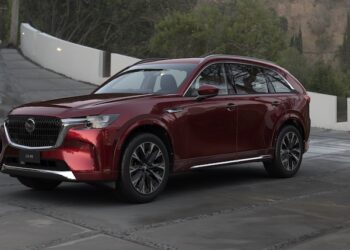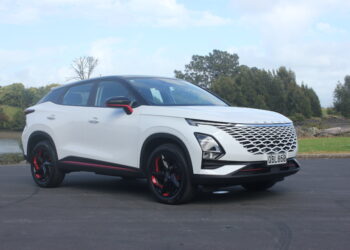
The 2.0-litre front-wheel drive SUV has long since replaced station wagons as the fleet vehicle of choice because of a combination of commanding driving position, occupant comfort, and cargo space.
Kia launched the 2022 Sportage range in January with a $34,990 introductory offer (MLP $39,990) on the entry level 2.0-litre LX front-wheel drive model for canny fleet operators who knew a good deal when they saw it.
For an entry level fleet model the Sportage LX is well equipped and standard equipment includes 17-inch alloy wheels, rear view monitor with dynamic guidelines, and Smart Cruise Control (SCC) with stop and go.
There are also LED headlights, eightinch touchscreen infotainment, 4.2- inch TFT LCD cluster, front parking sensors , and heated-and-folding side mirrors.
The new Sportage has grown. With a length of 4660mm and a width of 1865mm, its dimensions are comparable to the XM-series Kia Sorento seven-seat SUV which Kia built from 2009 to 2014.
The larger exterior transfers through to the inside of the vehicle, providing space for the driver and up to four passengers and their luggage.
To maximise convenience, the rear seats split 60:40 split and can fold flat to enable a through-loading cargo space which can accommodate either one or two passengers, and longer items, at the same time.
THE RANGE

The Sportage is available in four different trim levels with two different petrol and one diesel engine in a mix of two-wheel and all-wheel drive versions. The range starts with the front-wheel drive 2.0-litre petrol LX Urban from $39,990 and LX+ Urban from $40,990.
The all-wheel drive turbocharged 1.6-litre petrol models begin with the Deluxe 1.6T from $48,990 and the X-Line 1.6T from $56,990.
Next up are the 2.0-litre turbodiesel all-wheel drive models starting with the LX diesel at $45,990, the LX+ diesel from $48,990, the Deluxe diesel from $51,990, and the X-Line diesel from $61,990.
THE LOOK
Kia Design Centre head and senior vice president, Karim Habib, a Canadian of Lebanese descent, drove the brand’s new Opposites United design language which debuted with the 2022 Sportage.
Habib and his team have given the Sportage a much sleeker and futuristic look but have retained the signature Tiger Nose grille which has adorned the last two generations of this model.
In the 2022 Sportage the distinctive boomerang-shaped LED Daytime Running Lights (DRLs), create solid boundary lines for the LED MFR-type headlights.
Though the two previous Sportages had fairly flat upright tailgates, the new model has a more muscular fastback design flowing into the razor-like taillights which Kia says have been crafted to give the impression that they cut into the body with “fine precision”.
The new look gives the Sportage more on-road presence in all colours other than Fusion Black which seems to hide the body panels’ curvature. Inside At the centre of the Sportage’s cabin is a sculpted integrated curved display with a slim touchscreen pad and detailed air vents.
The designers say the curved display which sweeps across the front, gives the cabin dramatic width and depth creating a driver-orientated space.
It’s a more contemporary look for Kia, which has always had a more conservative dashboard and interior, but the ergonomics are excellent, and the touchscreen is one of the most responsive we’ve encountered. The overall design of the dashboard, centre console and door cards is unique and well executed.
Kia has tried and succeeded by injecting its personality into the car, rather than the vehicle being a Euro clone.
Sometimes functionality is lost within the design of such things, but not in the case of the Sportage’s major controls which are easy and intuitive for both the driver and front seat occupant to operate.
Most importantly, particularly in the Sportage LX, the new seats are comfortable, well-padded, and easily adjustable for all sizes of driver, and the steering wheel is fully adjustable.
THE DRIVE
The 2.0-litre petrol engine, available in LX and LX+, produces 115kW of power and 192Nm of torque. The 1.6-litre turbocharged engine with AWD in Deluxe and X-Line trim, sees power and torque increase to 132kW and 265Nm.
Quoted fuel consumption for the 2.0-litre petrol engine is 8.1 litres/100km, which improves to 7.2 litres/100km for its 1.6-litre turbocharged stablemate.
The 2.0-litre diesel in all four trim levels features AWD as standard. It generates137kW of power and 416Nm of torque and has a fuel efficiency of 6.3 litres/100km. Both petrol variants are rated to tow 1650kg braked, which increases to 1900kg braked for the diesels.
The power and torque from the naturally aspirated 2.0-litre engine are adequate rather than startling, but the car does its best work on the motorway and open road providing quiet and economical performance.
Stop/start urban motoring will see consumption rise a litre or two above the combined figures quoted above. All three engines fall in the neutral zone of the Government’s Clean Car Standard and don’t attract a fee or a discount.
SAFETY
A comprehensive suite of passive and active safety features is standard across the Sportage range.
As part of its advanced driver assistance (ADAS) package, the Sportage has forward collision-avoidance assist (FCA), which helps avoid collisions with objects in front of the vehicle.
When operating the turning signal to change lanes, if there’s a risk of collision with a rear-side vehicle, a new blind spot collision-avoidance assist (BCA) system provides a warning to the driver.
After the warning, if the risk of collision increases, BCA actively controls the all-new Sportage to help avoid a collision.
BCA is also active in situations like parallel parking, further helping to avoid collision with rear-side vehicles.
More standard features include rear cross-traffic collision avoidance (RCA), lane keep assist (LKA), and lane follow assist (LFA).
OUR VIEW
Over five generations Kia has evolved the Sportage from an old-school ladder-chassis 4×4 wagon into a compact crossover and now a strikinglooking SUV which combines form with function. It’s certainly a Vegemite car – you’ll like the look or you won’t.
Most importantly the entry-level 2.0-litre petrol LX isn’t a strippedout version but a vehicle that’s well equipped and specified for fleet users.
It has high levels of standard safety features including the smart cruise function which is appreciated by drivers who use busy motorways.
There’ll be some fleet buyers who consider the LX version of the allwheel drive 2.0-litre turbodiesel for very high-mileage applications, or where a greater towing capacity is required.
But for most, the performance of the petrol version should be enough.








